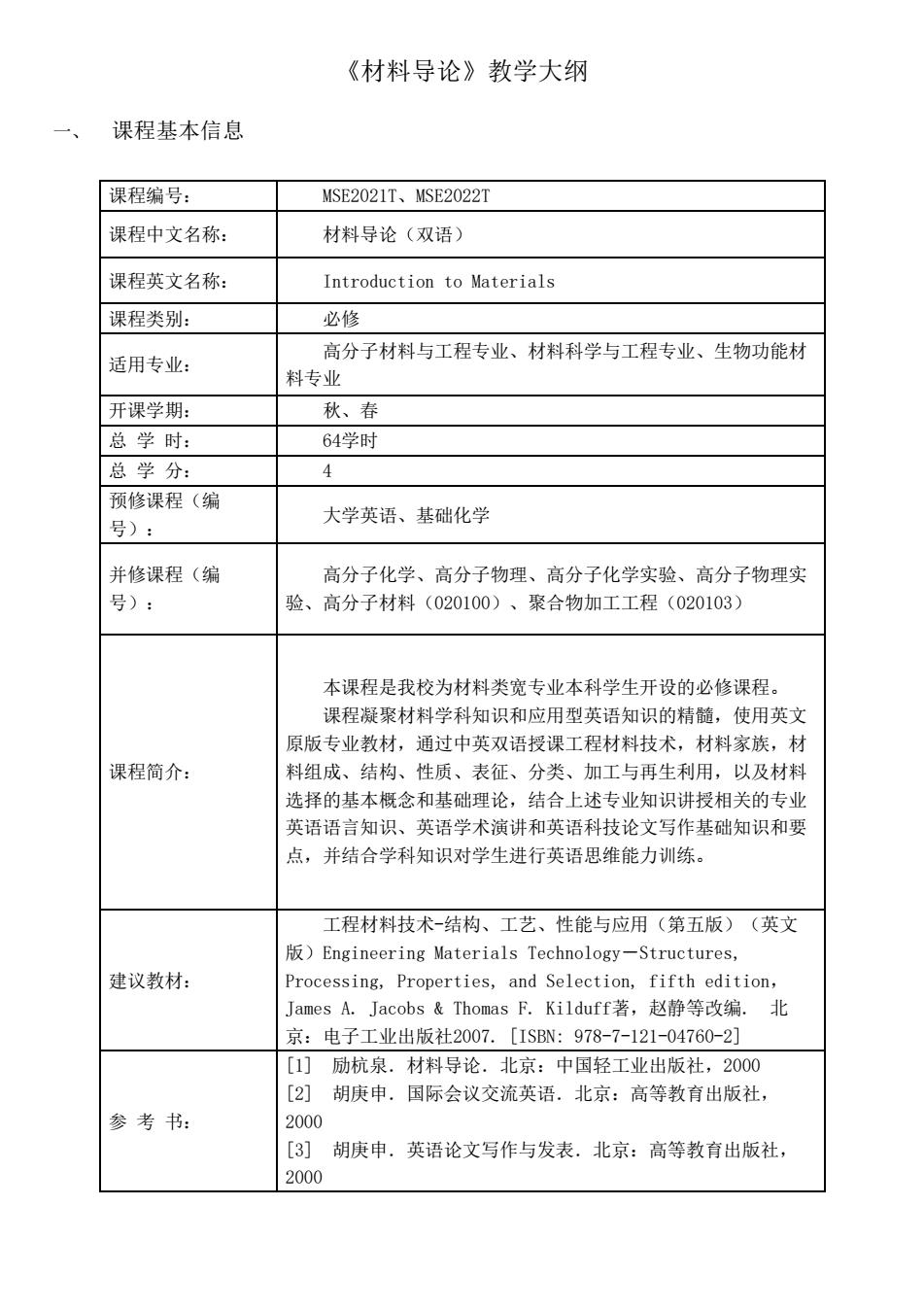
《材料导论》教学大纲 一、 课程基本信息 课程编号: AMSE2021T、MSE2022T 课程中文名称: 材料导论(双语) 课程英文名称: Introduction to Materials 课程类别: 必修 适用专业: 高分子材料与工程专业、材料科学与工程专业、生物功能材 料专业 开课学期: 秋、春 总学时: 64学时 总学分: 4 预修课程(编 号): 大学英语、基础化学 并修课程(编 高分子化学、高分子物理、高分子化学实验、高分子物理实 号): 验、高分子材料(020100)、聚合物加工工程(020103) 本课程是我校为材料类宽专业本科学生开设的必修课程。 课程凝聚材料学科知识和应用型英语知识的精髓,使用英文 原版专业教材,通过中英双语授课工程材料技术,材料家族,材 课程简介: 料组成、结构、性质、表征、分类、加工与再生利用,以及材料 选择的基本概念和基础理论,结合上述专业知识讲授相关的专业 英语语言知识、英语学术演讲和英语科技论文写作基础知识和要 点,并结合学科知识对学生进行英语思维能力训练。 工程材料技术-结构、工艺、性能与应用(第五版)(英文 )Engineering Materials Technology-Structures, 建议教材: Processing,Properties,and Selection,fifth edition, James A.Jacobs&Thomas F.Kilduff著,赵静等改编. 北 京:电子工业出版社2007.[ISBN:978-7-121-04760-2] [1]励杭泉.材料导论.北京:中国轻工业出版社,2000 [2]胡庚申.国际会议交流英语。北京:高等教育出版社 参考书: 2000 [3】胡庚申,英语论文写作与发表.北京:高等教育出版社 2000
《材料导论》教学大纲 一、 课程基本信息 课程编号: MSE2021T、MSE2022T 课程中文名称: 材料导论(双语) 课程英文名称: Introduction to Materials 课程类别: 必修 适用专业: 高分子材料与工程专业、材料科学与工程专业、生物功能材 料专业 开课学期: 秋、春 总 学 时: 64学时 总 学 分: 4 预修课程(编 号): 大学英语、基础化学 并修课程(编 号): 高分子化学、高分子物理、高分子化学实验、高分子物理实 验、高分子材料(020100)、聚合物加工工程(020103) 课程简介: 本课程是我校为材料类宽专业本科学生开设的必修课程。 课程凝聚材料学科知识和应用型英语知识的精髓,使用英文 原版专业教材,通过中英双语授课工程材料技术,材料家族,材 料组成、结构、性质、表征、分类、加工与再生利用,以及材料 选择的基本概念和基础理论,结合上述专业知识讲授相关的专业 英语语言知识、英语学术演讲和英语科技论文写作基础知识和要 点,并结合学科知识对学生进行英语思维能力训练。 建议教材: 工程材料技术-结构、工艺、性能与应用(第五版)(英文 版)Engineering Materials Technology-Structures, Processing, Properties, and Selection, fifth edition, James A. Jacobs & Thomas F. Kilduff著,赵静等改编. 北 京:电子工业出版社2007. [ISBN: 978-7-121-04760-2] 参 考 书: [1] 励杭泉.材料导论.北京:中国轻工业出版社,2000 [2] 胡庚申.国际会议交流英语.北京:高等教育出版社, 2000 [3] 胡庚申.英语论文写作与发表.北京:高等教育出版社, 2000
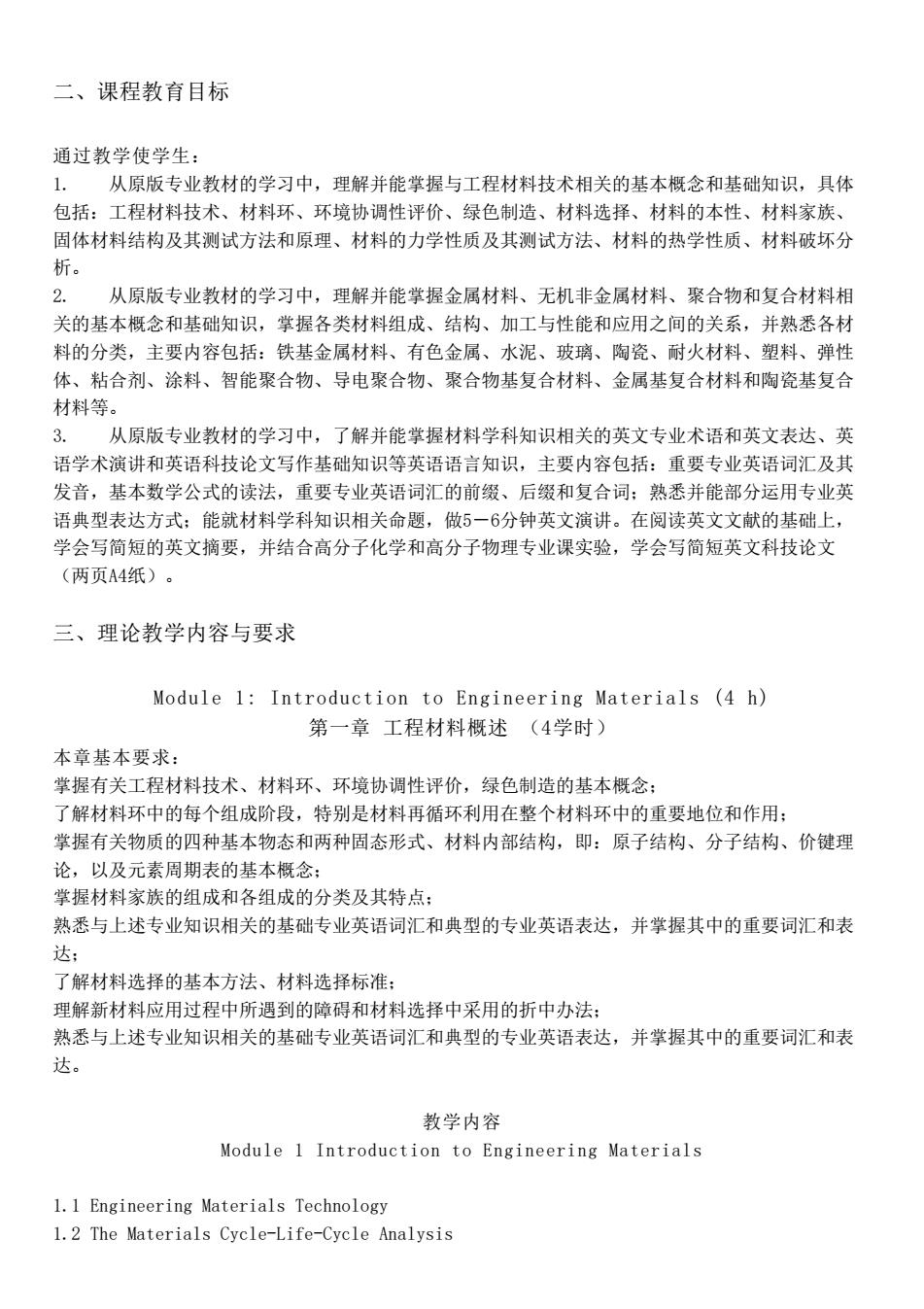
二、课程教育目标 通过教学使学生: 1. 从原版专业教材的学习中,理解并能学握与工程材料技术相关的基本概念和基础知识,具体 包括:工程材料技术、材料环、环境协调性评价、绿色制造、材料选择、材料的本性、材料家族、 固体材料结构及其测试方法和原理、材料的力学性质及其测试方法、材料的热学性质、材料破坏分 析。 2. 从原版专业教材的学习中,理解并能掌握金属材料、无机非金属材料、聚合物和复合材料相 关的基本概念和基础知识,掌握各类材料组成、结构、加工与性能和应用之间的关系,并熟悉各材 料的分类,主要内容包括:铁基金属材料、有色金属、水泥、玻璃、陶瓷、耐火材料、塑料、弹性 体、粘合剂、涂料、智能聚合物、导电聚合物、聚合物基复合材料、金属基复合材料和陶瓷基复合 材料等。 从原版专业教材的学习中,了解并能掌握材料学科知识相关的英文专业术语和英文表达、英 语学术演讲和英语科技论文写作基础知识等英语语言知识,主要内容包括:重要专业英语词汇及其 发音,基本数学公式的读法,重要专业英语词汇的前缀、后缀和复合词:熟悉并能部分运用专业英 语典型表达方式:能就材料学科知识相关命题,做5一6分钟英文演讲。在阅读英文文献的基础上, 学会写简短的英文摘要,并结合高分子化学和高分子物理专业课实验,学会写简短英文科技论文 (两页A4纸)。 三、理论教学内容与要求 Module 1:Introduction to Engineering Materials (4 h) 第一章工程材料概述(4学时) 本章基本要求: 掌握有关工程材料技术、材料环、环境协调性评价,绿色制造的基本概念: 了解材料环中的每个组成阶段,特别是材料再循环利用在整个材料环中的重要地位和作用: 掌握有关物质的四种基本物态和两种固态形式、材料内部结构,即:原子结构、分子结构、价健理 论,以及元素周期表的基本概念: 掌握材料家族的组成和各组成的分类及其特点: 熟悉与上述专业知识相关的基础专业英语词汇和典型的专业英语表达,并掌握其中的重要词汇和表 达: 了解材料选择的基本方法、材料选择标准: 理解新材料应用过程中所過到的障碍和材料选择中采用的折中办法: 熟悉与上述专业知识相关的基础专业英语词汇和典型的专业英语表达,并掌握其中的重要词汇和表 达。 教学内容 Module 1 Introduction to Engineering Materials 1.1 Engineering Materials Technology 1.2 The Materials Cycle-Life-Cycle Analysis
二、课程教育目标 通过教学使学生: 1. 从原版专业教材的学习中,理解并能掌握与工程材料技术相关的基本概念和基础知识,具体 包括:工程材料技术、材料环、环境协调性评价、绿色制造、材料选择、材料的本性、材料家族、 固体材料结构及其测试方法和原理、材料的力学性质及其测试方法、材料的热学性质、材料破坏分 析。 2. 从原版专业教材的学习中,理解并能掌握金属材料、无机非金属材料、聚合物和复合材料相 关的基本概念和基础知识,掌握各类材料组成、结构、加工与性能和应用之间的关系,并熟悉各材 料的分类,主要内容包括:铁基金属材料、有色金属、水泥、玻璃、陶瓷、耐火材料、塑料、弹性 体、粘合剂、涂料、智能聚合物、导电聚合物、聚合物基复合材料、金属基复合材料和陶瓷基复合 材料等。 3. 从原版专业教材的学习中,了解并能掌握材料学科知识相关的英文专业术语和英文表达、英 语学术演讲和英语科技论文写作基础知识等英语语言知识,主要内容包括:重要专业英语词汇及其 发音,基本数学公式的读法,重要专业英语词汇的前缀、后缀和复合词;熟悉并能部分运用专业英 语典型表达方式;能就材料学科知识相关命题,做5-6分钟英文演讲。在阅读英文文献的基础上, 学会写简短的英文摘要,并结合高分子化学和高分子物理专业课实验,学会写简短英文科技论文 (两页A4纸)。 三、理论教学内容与要求 Module 1: Introduction to Engineering Materials (4 h) 第一章 工程材料概述 (4学时) 本章基本要求: 掌握有关工程材料技术、材料环、环境协调性评价,绿色制造的基本概念; 了解材料环中的每个组成阶段,特别是材料再循环利用在整个材料环中的重要地位和作用; 掌握有关物质的四种基本物态和两种固态形式、材料内部结构,即:原子结构、分子结构、价键理 论,以及元素周期表的基本概念; 掌握材料家族的组成和各组成的分类及其特点; 熟悉与上述专业知识相关的基础专业英语词汇和典型的专业英语表达,并掌握其中的重要词汇和表 达; 了解材料选择的基本方法、材料选择标准; 理解新材料应用过程中所遇到的障碍和材料选择中采用的折中办法; 熟悉与上述专业知识相关的基础专业英语词汇和典型的专业英语表达,并掌握其中的重要词汇和表 达。 教学内容 Module 1 Introduction to Engineering Materials 1.1 Engineering Materials Technology 1.2 The Materials Cycle-Life-Cycle Analysis
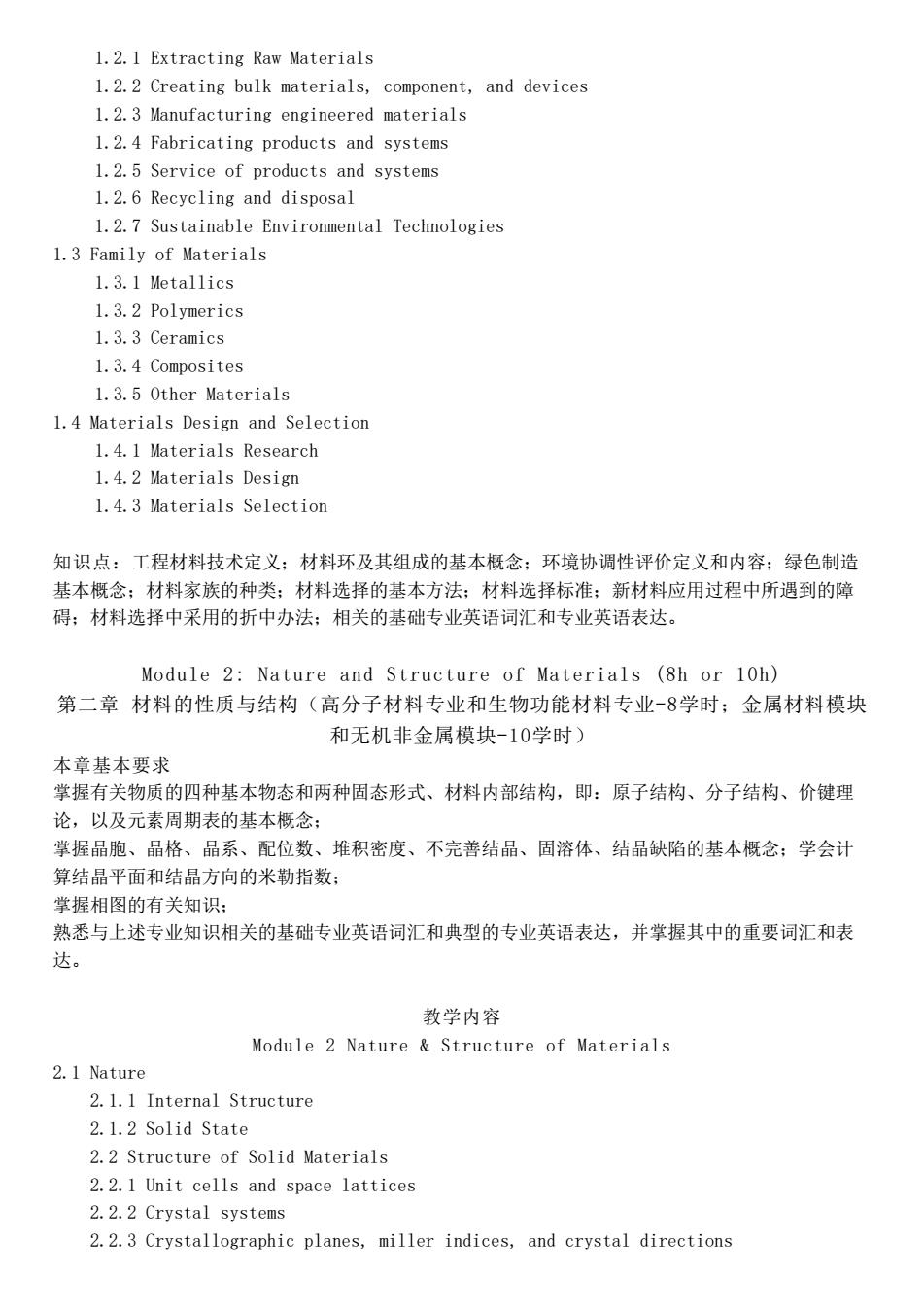
1.2.1 Extracting Raw Materials 1.2.2 Creating bulk materials,component,and devices 1.2.3 Manufacturing engineered materials 1.2.4 Fabricating products and systems 1.2.5 Service of products and systems 1.2.6 Recycling and disposal 1.2.7 Sustainable Environmental Technologies 1.3 Family of Materials 1.3.1 Metallics 1.3.2 Polymerics 1.3.3 Ceramics 1.3.4 Composites 1.3.5 0ther Materials 1.4 Materials Design and Selection 1.4.1 Materials Research 1.4.2 Materials Design 1.4.3 Materials Selectior 知识点:工程材料技术定义:材料环及其组成的基本概念;环境协调性评价定义和内容:绿色制造 基本概念:材料家族的种类:材料选择的基本方法:材料选择标准:新材料应用过程中所遇到的障 碍:材料选择中采用的折中办法:相关的基础专业英语词汇和专业英语表达。 Module 2:Nature and Structure of Materials (8h or 10h) 第二章材料的性质与结构(高分子材料专业和生物功能材料专业-8学时:金属材料模块 和无机非金属模块-10学时) 本章基本要求 掌握有关物质的四种基本物态和两种固态形式、材料内部结构,即:原子结构、分子结构、价键理 论,以及元素周期表的基本概念: 掌握晶胞、晶格、晶系、配位数、堆积密度、不完善结晶、固溶体、结晶缺陷的基本概念:学会计 算结晶平面和结晶方向的米勒指数: 学握相图的有关知识: 熟悉与上述专业知识相关的基础专业英语词汇和典型的专业英语表达,并掌握其中的重要词汇和表 达。 教学内容 Module 2 Nature Structure of Materials 2.1 Nature 2.1.1 Internal Structure 2.1.2 Solid State 2.2 Structure of Solid Materials 2.2.1 Unit cells and space lattices 2.2.2 Crystal systems 2.2.3 Crystallographic planes,miller indices,and crystal directions
1.2.1 Extracting Raw Materials 1.2.2 Creating bulk materials, component, and devices 1.2.3 Manufacturing engineered materials 1.2.4 Fabricating products and systems 1.2.5 Service of products and systems 1.2.6 Recycling and disposal 1.2.7 Sustainable Environmental Technologies 1.3 Family of Materials 1.3.1 Metallics 1.3.2 Polymerics 1.3.3 Ceramics 1.3.4 Composites 1.3.5 Other Materials 1.4 Materials Design and Selection 1.4.1 Materials Research 1.4.2 Materials Design 1.4.3 Materials Selection 知识点:工程材料技术定义;材料环及其组成的基本概念;环境协调性评价定义和内容;绿色制造 基本概念;材料家族的种类;材料选择的基本方法;材料选择标准;新材料应用过程中所遇到的障 碍;材料选择中采用的折中办法;相关的基础专业英语词汇和专业英语表达。 Module 2: Nature and Structure of Materials (8h or 10h) 第二章 材料的性质与结构(高分子材料专业和生物功能材料专业-8学时;金属材料模块 和无机非金属模块-10学时) 本章基本要求 掌握有关物质的四种基本物态和两种固态形式、材料内部结构,即:原子结构、分子结构、价键理 论,以及元素周期表的基本概念; 掌握晶胞、晶格、晶系、配位数、堆积密度、不完善结晶、固溶体、结晶缺陷的基本概念;学会计 算结晶平面和结晶方向的米勒指数; 掌握相图的有关知识; 熟悉与上述专业知识相关的基础专业英语词汇和典型的专业英语表达,并掌握其中的重要词汇和表 达。 教学内容 Module 2 Nature & Structure of Materials 2.1 Nature 2.1.1 Internal Structure 2.1.2 Solid State 2.2 Structure of Solid Materials 2.2.1 Unit cells and space lattices 2.2.2 Crystal systems 2.2.3 Crystallographic planes, miller indices, and crystal directions
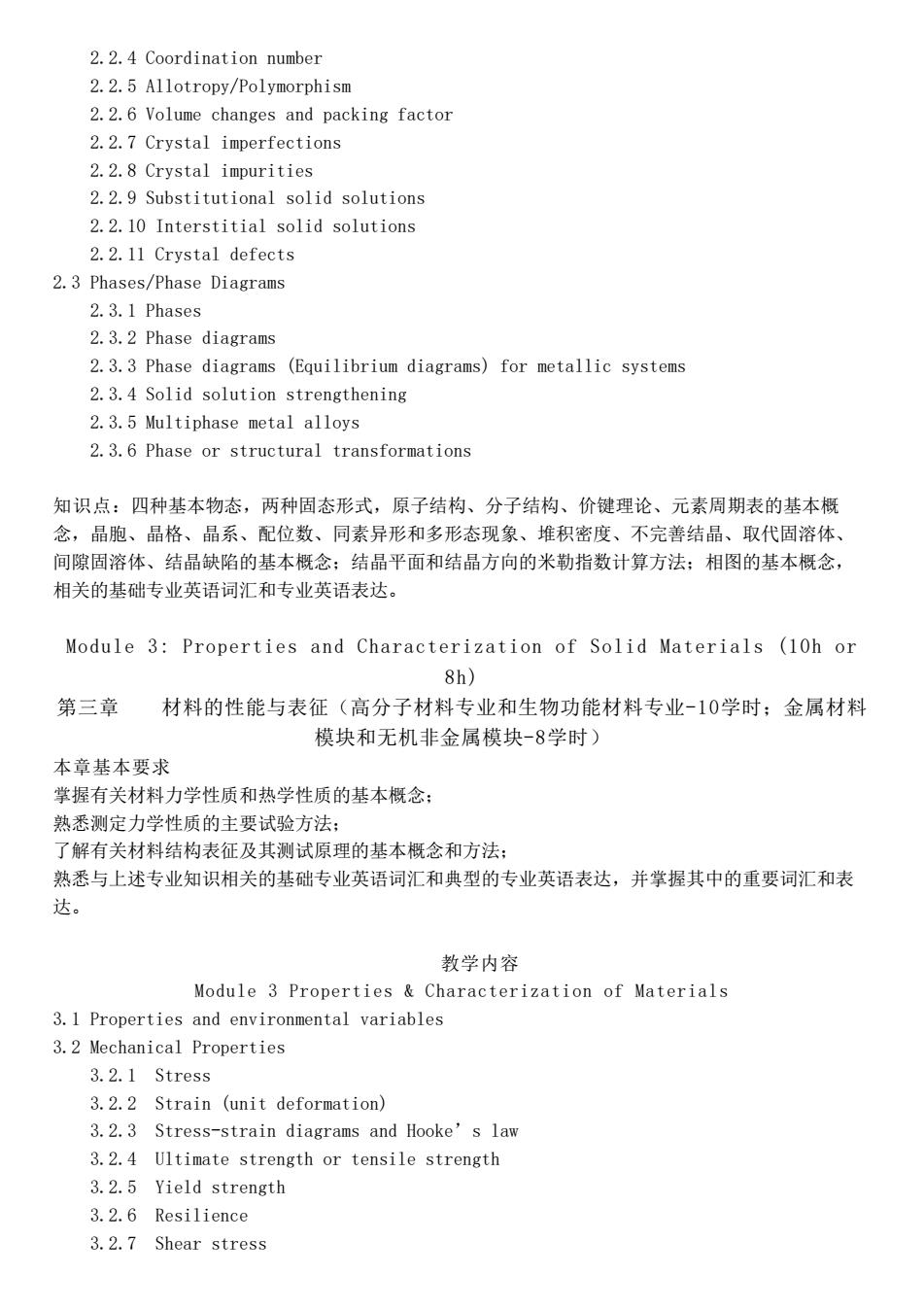
2.2.4 Coordination number 2.2.5 Allotropy/Polymorphism 2.2.6 Volume changes and packing factor 2.2.7 Crystal imperfections 2.2.8 Crystal impurities 2.2.9 Substitutional solid solutions 2.2.10 Interstitial solid solutions 2.2.11 Crystal defects 2.3 Phases/Phase Diagrams 2.3.1 Phases 2.3.2 Phase diagrams 2.3.3 Phase diagrams (Equilibrium diagrams)for metallic systems 2.3.4 Solid solution strengthening 2.3.5 Multiphase metal alloys 2.3.6 Phase or structural transformations 知识点:四种基本物态,两种固态形式,原子结构、分子结构、价键理论、元素周期表的基本概 念,晶胞、晶格、晶系、配位数、同素异形和多形态现象、堆积密度、不完善结晶、取代固溶体、 间隙固溶体、结晶缺陷的基本概念:结晶平面和结晶方向的米勒指数计算方法:相图的基本概念, 相关的基础专业英语词汇和专业英语表达。 Module 3:Properties and Characterization of Solid Materials (10h or 8h) 第三章 材料的性能与表征(高分子材料专业和生物功能材料专业-10学时;金属材料 模块和无机非金属模块-8学时) 本章基本要求 掌握有关材料力学性质和热学性质的基本概念: 熟悉测定力学性质的主要试验方法: 了解有关材料结构表征及其测试原理的基本概念和方法: 熟悉与上述专业知识相关的基础专业英语词汇和典型的专业英语表达,并掌握其中的重要词汇和表 达。 教学内容 Module 3 Properties Characterization of Materials 3.1 Properties and environmental variables 3.2 Mechanical Properties 3.2.1 Stress 3.2.2 Strain (unit deformation) 3.2.3 Stress-strain diagrams and Hooke's law 3.2.4 Ultimate strength or tensile strength 3.2.5 Yield strength 3.2.6 Resilience 3.2.7 Shear stress
2.2.4 Coordination number 2.2.5 Allotropy/Polymorphism 2.2.6 Volume changes and packing factor 2.2.7 Crystal imperfections 2.2.8 Crystal impurities 2.2.9 Substitutional solid solutions 2.2.10 Interstitial solid solutions 2.2.11 Crystal defects 2.3 Phases/Phase Diagrams 2.3.1 Phases 2.3.2 Phase diagrams 2.3.3 Phase diagrams (Equilibrium diagrams) for metallic systems 2.3.4 Solid solution strengthening 2.3.5 Multiphase metal alloys 2.3.6 Phase or structural transformations 知识点:四种基本物态,两种固态形式,原子结构、分子结构、价键理论、元素周期表的基本概 念,晶胞、晶格、晶系、配位数、同素异形和多形态现象、堆积密度、不完善结晶、取代固溶体、 间隙固溶体、结晶缺陷的基本概念;结晶平面和结晶方向的米勒指数计算方法;相图的基本概念, 相关的基础专业英语词汇和专业英语表达。 Module 3: Properties and Characterization of Solid Materials (10h or 8h) 第三章 材料的性能与表征(高分子材料专业和生物功能材料专业-10学时;金属材料 模块和无机非金属模块-8学时) 本章基本要求 掌握有关材料力学性质和热学性质的基本概念; 熟悉测定力学性质的主要试验方法; 了解有关材料结构表征及其测试原理的基本概念和方法; 熟悉与上述专业知识相关的基础专业英语词汇和典型的专业英语表达,并掌握其中的重要词汇和表 达。 教学内容 Module 3 Properties & Characterization of Materials 3.1 Properties and environmental variables 3.2 Mechanical Properties 3.2.1 Stress 3.2.2 Strain (unit deformation) 3.2.3 Stress-strain diagrams and Hooke’s law 3.2.4 Ultimate strength or tensile strength 3.2.5 Yield strength 3.2.6 Resilience 3.2.7 Shear stress
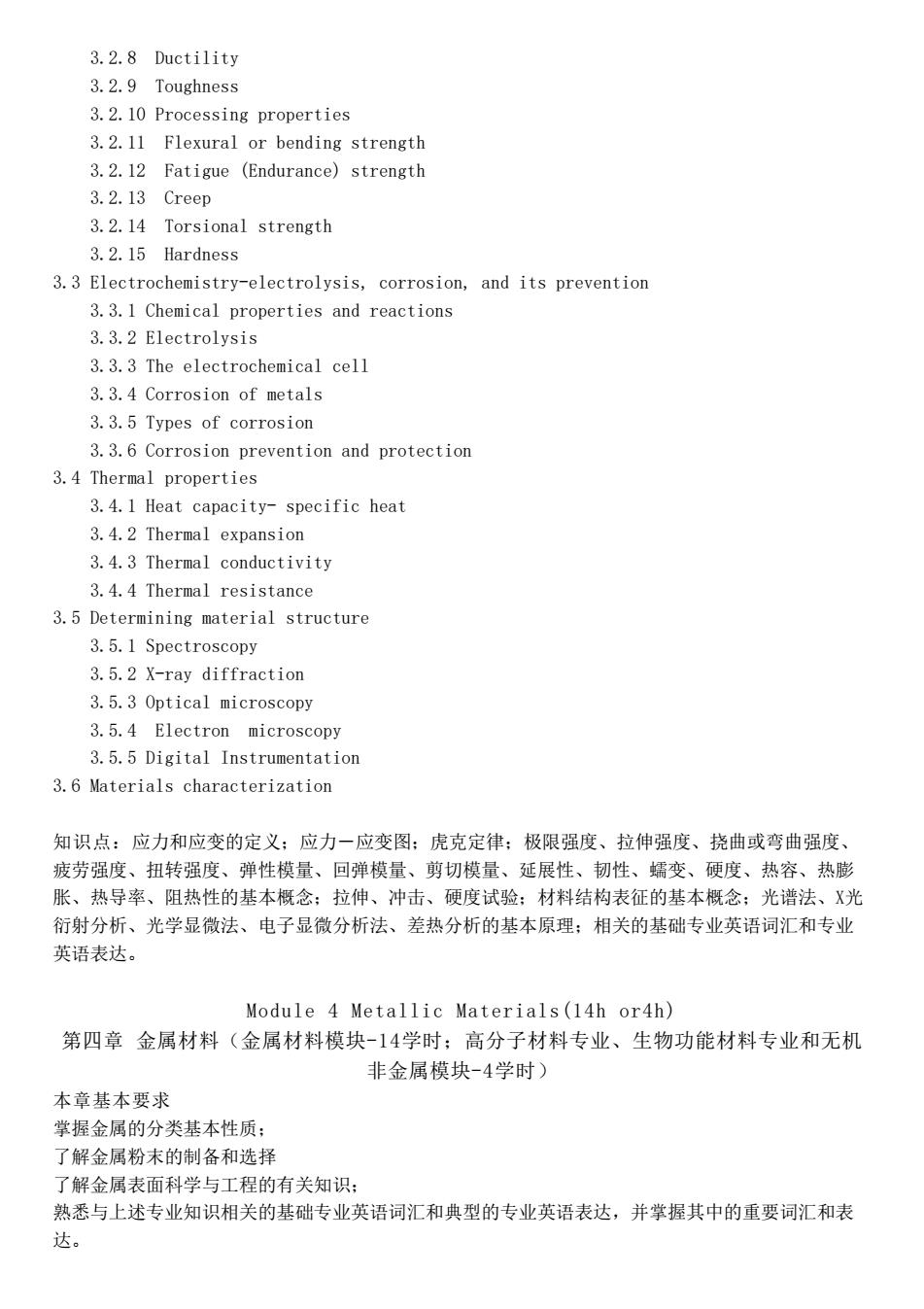
3.2.8 Ductility 3.2.9Toughness 3.2.10 Processing properties 3.2.11 Flexural or bending strength 3.2.12 Fatigue (Endurance)strength 3.2.13 Creep 3.2.14 Torsional strength 3.2.15 Hardness 3.3 Electrochemistry-electrolysis,corrosion,and its prevention 3.3.1 Chemical properties and reactions 3.3.2 Electrolysis 3.3.3 The electrochemical cell 3.3.4 Corrosion of metals 3.3.5 Types of corrosion 3.3.6 Corrosion prevention and protection 3.4 Thermal properties 3.4.1 Heat capacity-specific heat 3.4.2 Thermal expansion 3.4.3 Thermal conductivity 3.4.4 Thermal resistance 3.5 Determining material structure 3.5.1 Spectroscopy 3.5.2 X-ray diffraction 3.5.3 Optical microscopy 3.5.4 Electron microscopy 3.5.5 Digital Instrumentation 3.6 Materials characterization 知识点:应力和应变的定义:应力一应变图:虎克定律:极限强度、拉伸强度、挠曲或弯曲强度、 店劳强度、扭转强度、弹性模量、问弹模量、煎切模最、征据性、韧性、压变、硬度、热容、热影 胀、热导率、阻热性的基本概念:拉伸、冲击、硬度试验:材料结构表征的基本概念:光谱法、X光 衍射分析、光学显微法、电子显微分析法、差热分析的基本原理:相关的基础专业英语词汇和专业 英语表达。 Module 4 Metallic Materials(14h or4h) 第四章金属材料(金属材料模块-14学时;高分子材料专业、生物功能材料专业和无机 非金属模块-4学时) 本章基本要求 学握金属的分类基本性质: 了解金属粉末的制备和选择 了解金属表面科学与工程的有关知识: 熟悉与上述专业知识相关的基础专业英语词汇和典型的专业英语表达,并掌握其中的重要词汇和表 达
3.2.8 Ductility 3.2.9 Toughness 3.2.10 Processing properties 3.2.11 Flexural or bending strength 3.2.12 Fatigue (Endurance) strength 3.2.13 Creep 3.2.14 Torsional strength 3.2.15 Hardness 3.3 Electrochemistry-electrolysis, corrosion, and its prevention 3.3.1 Chemical properties and reactions 3.3.2 Electrolysis 3.3.3 The electrochemical cell 3.3.4 Corrosion of metals 3.3.5 Types of corrosion 3.3.6 Corrosion prevention and protection 3.4 Thermal properties 3.4.1 Heat capacity- specific heat 3.4.2 Thermal expansion 3.4.3 Thermal conductivity 3.4.4 Thermal resistance 3.5 Determining material structure 3.5.1 Spectroscopy 3.5.2 X-ray diffraction 3.5.3 Optical microscopy 3.5.4 Electron microscopy 3.5.5 Digital Instrumentation 3.6 Materials characterization 知识点:应力和应变的定义;应力-应变图;虎克定律;极限强度、拉伸强度、挠曲或弯曲强度、 疲劳强度、扭转强度、弹性模量、回弹模量、剪切模量、延展性、韧性、蠕变、硬度、热容、热膨 胀、热导率、阻热性的基本概念;拉伸、冲击、硬度试验;材料结构表征的基本概念;光谱法、X光 衍射分析、光学显微法、电子显微分析法、差热分析的基本原理;相关的基础专业英语词汇和专业 英语表达。 Module 4 Metallic Materials(14h or4h) 第四章 金属材料(金属材料模块-14学时;高分子材料专业、生物功能材料专业和无机 非金属模块-4学时) 本章基本要求 掌握金属的分类基本性质; 了解金属粉末的制备和选择 了解金属表面科学与工程的有关知识; 熟悉与上述专业知识相关的基础专业英语词汇和典型的专业英语表达,并掌握其中的重要词汇和表 达

教学内容 Module 4 Metallic materials 4.1 Nature and Thermal Processing of Metals 4.1.1 Nature of Metals 4.1.2 Thermal processing of steel:equilibrium conditions 4.1.3 Thermal processing of steel:near-equilibrium conditions 4.1.4 Thermal processing of steel:nonequilibrium conditions 4.1.5 Precipitation strengthening/Hardening (age hardening) 4.1.6 Hardenability 4.2 Ferrous Metals 4.2.1 Ferrous metals 4.2.2 Cast iron 4.2.3 Steel 4.3 Nonferrous Metals 4.3.1 Aluminum 4.3.2 Coppe 4.3.3 Nickel 4.3.4 Magnesium 4.3.5 Titanium 4.3.6 White Metals 4.3.7 Other metals 4.4 Metal Powders 4.4.1 P/M Production 4.4.2 P/M Selection 4.4.3 Metal Powders 4.4.4 P/M Cost 4.5 Surface Science and Engineering 4.5.1 Surface Science and Surface Engineering 4.5.2 Surface Treatments 4.5.3 Surface hardening and surface modification 知识点:金属的性质:黑色金属及其种类:有色金属及其种类:金属粉末:表面处理:相关的 基础专业英语词汇和专业英语表达。 Module 5:Polymeric Materials (14h or 4h) 第五章聚合物材料(高分子材料专业和生物功能材料专业-14学时;金属材料模块和无 机非金属模块-4学时) 本章基本要求 掌握有关聚合物本性、聚合反应、聚合物结构的基本概念。 掌握塑料、弹性体和黏合剂的定义、分类、性质、加工和选择: 了解涂料、智能聚合物、导电聚合物、土工合成材料、木材及其相关产品等重要聚合物材料: 熟悉常见通用塑料、工程塑料、弹性体英文名称和缩写及常见黏合剂的英文名称:
教学内容 Module 4 Metallic materials 4.1 Nature and Thermal Processing of Metals 4.1.1 Nature of Metals 4.1.2 Thermal processing of steel: equilibrium conditions 4.1.3 Thermal processing of steel: near-equilibrium conditions 4.1.4 Thermal processing of steel: nonequilibrium conditions 4.1.5 Precipitation strengthening/Hardening (age hardening) 4.1.6 Hardenability 4.2 Ferrous Metals 4.2.1 Ferrous metals 4.2.2 Cast iron 4.2.3 Steel 4.3 Nonferrous Metals 4.3.1 Aluminum 4.3.2 Copper 4.3.3 Nickel 4.3.4 Magnesium 4.3.5 Titanium 4.3.6 White Metals 4.3.7 Other metals 4.4 Metal Powders 4.4.1 P/M Production 4.4.2 P/M Selection 4.4.3 Metal Powders 4.4.4 P/M Cost 4.5 Surface Science and Engineering 4.5.1 Surface Science and Surface Engineering 4.5.2 Surface Treatments 4.5.3 Surface hardening and surface modification 知识点:金属的性质;黑色金属及其种类;有色金属及其种类;金属粉末;表面处理;相关的 基础专业英语词汇和专业英语表达。 Module 5: Polymeric Materials (14h or 4h) 第五章 聚合物材料(高分子材料专业和生物功能材料专业-14学时;金属材料模块和无 机非金属模块-4学时) 本章基本要求 掌握有关聚合物本性、聚合反应、聚合物结构的基本概念; 掌握塑料、弹性体和黏合剂的定义、分类、性质、加工和选择; 了解涂料、智能聚合物、导电聚合物、土工合成材料、木材及其相关产品等重要聚合物材料; 熟悉常见通用塑料、工程塑料、弹性体英文名称和缩写及常见黏合剂的英文名称;
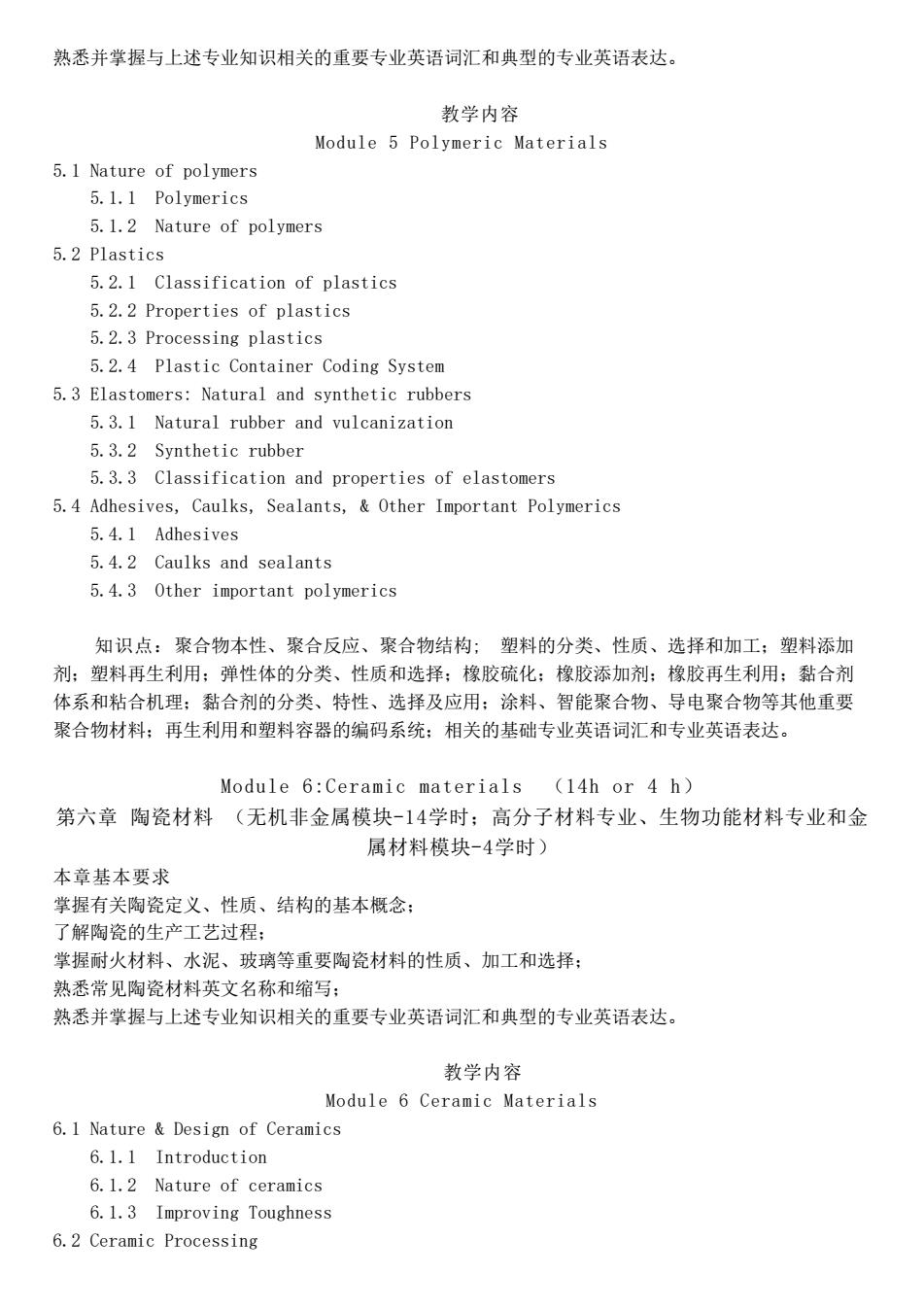
熟悉并学握与上述专业知识相关的重要专业英语词汇和典型的专业英语表达。 教学内容 Module 5 Polymeric Materials 5.1 Nature of polymers 5.1.1 Polymerics 5.1.2 Nature of polymers 5.2 Plastics 5.2.1 Classification of plastics 5.2.2 Properties of plastics 5.2.3 Processing plastics 5.2.4 Plastic Container Coding System 5.3 Elastomers:Natural and synthetic rubbers 5.3.1 Natural rubber and vulcanization 5.3.2 Synthetic rubber 5.3.3 Classification and properties of elastomers 5.4 Adhesives,Caulks,Sealants,Other Important Polymerics 5.4.1 Adhesives 5.4.2 Caulks and sealants 5.4.3 Other important polymerics 知识点:聚合物本性、聚合反应、聚合物结构:塑料的分类、性质、选择和加工:塑料添加 剂:塑料再生利用:弹性体的分类、性质和选择:橡胶硫化:橡胶添加剂:橡胶再生利用:黏合剂 体系和粘合机理:黏合剂的分类、特性、选择及应用:涂料、智能聚合物、导电聚合物等其他重要 聚合物材料:再生利用和塑料容器的编码系统:相关的基础专业英语词汇和专业英语表达。 Module 6:Ceramic materials (14h or 4 h) 第六章陶瓷材料(无机非金属模块-14学时;高分子材料专业、生物功能材料专业和金 属材料模块-4学时) 本章基本要求 学握有关陶瓷定义、性质、结构的基本概念 了解陶瓷的生产工艺过程: 掌握耐火材料、水泥、玻璃等重要陶瓷材料的性质、加工和选择: 熟悉常见陶瓷材料英文名称和缩写: 熟悉并掌握与上述专业知识相关的重要专业英语词汇和典型的专业英语表达。 教学内容 Module 6 Ceramic Materials 6.1 Nature Design of Ceramics 6.1.1 Introduction 6.1.2 Nature of ceramics 6.1.3 Improving Toughness 6.2 Ceramic Processing
熟悉并掌握与上述专业知识相关的重要专业英语词汇和典型的专业英语表达。 教学内容 Module 5 Polymeric Materials 5.1 Nature of polymers 5.1.1 Polymerics 5.1.2 Nature of polymers 5.2 Plastics 5.2.1 Classification of plastics 5.2.2 Properties of plastics 5.2.3 Processing plastics 5.2.4 Plastic Container Coding System 5.3 Elastomers: Natural and synthetic rubbers 5.3.1 Natural rubber and vulcanization 5.3.2 Synthetic rubber 5.3.3 Classification and properties of elastomers 5.4 Adhesives, Caulks, Sealants, & Other Important Polymerics 5.4.1 Adhesives 5.4.2 Caulks and sealants 5.4.3 Other important polymerics 知识点:聚合物本性、聚合反应、聚合物结构; 塑料的分类、性质、选择和加工;塑料添加 剂;塑料再生利用;弹性体的分类、性质和选择;橡胶硫化;橡胶添加剂;橡胶再生利用;黏合剂 体系和粘合机理;黏合剂的分类、特性、选择及应用;涂料、智能聚合物、导电聚合物等其他重要 聚合物材料;再生利用和塑料容器的编码系统;相关的基础专业英语词汇和专业英语表达。 Module 6:Ceramic materials (14h or 4 h) 第六章 陶瓷材料 (无机非金属模块-14学时;高分子材料专业、生物功能材料专业和金 属材料模块-4学时) 本章基本要求 掌握有关陶瓷定义、性质、结构的基本概念; 了解陶瓷的生产工艺过程; 掌握耐火材料、水泥、玻璃等重要陶瓷材料的性质、加工和选择; 熟悉常见陶瓷材料英文名称和缩写; 熟悉并掌握与上述专业知识相关的重要专业英语词汇和典型的专业英语表达。 教学内容 Module 6 Ceramic Materials 6.1 Nature & Design of Ceramics 6.1.1 Introduction 6.1.2 Nature of ceramics 6.1.3 Improving Toughness 6.2 Ceramic Processing

6.2.1 Thermal Processing-sintering/densification/firing 6.2.2 Traditional processing 6.2.3 Advanced ceramic processing 6.3 Refractories,Cement,Concrete,Clay,Abrasives,&Protective Coatings 6.3.1 Refractories 6.3.2 Cement and concrete 6.3.3C1ay 6.3.4 Abrasives 6.3.5 Protective Coatings 6.4 Glass 6.4.1 Nature of glass 6.4.2 Types and properties of glass 6.4.3 Glass-Ceramics Module 7:Composite Materials (10h) 第七章复合材料(10学时) 本章基本要求 了解复合材料的发展史 掌握复合材料的组成、结构和性质: 熟悉重要的复合材料类型 了解复合材料加工成型方法 掌握与上述专业知识相关的重要专业英语词汇和典型的专业英语表达。 教字内容 Module 7 Composite Materials 7.1 Introduction 7.1.1 Definition of composites 7.1.2 Development of composites 7.2 Constituents of fiber-reinforced composites 7.2.1 Fiber 7.2.2 Matrix 7.2.3 Interface and interphase 7.2.4 Fiber/matrix consolidation 7.3 Reinforcing Fibers 7.3.1 Types and Structures of Fibers 7.3.1.1 Glass fiber 7.3.1.2 Boron fiber 7.3.1.3 Carbon and graphite fibers 7.3.1.4 KevlarTM fiber 7.3.1.5 Ceramic fibers 7.3.1.6 High-performance manufactured polymeric fibers 7.3.1.7 Smart fibers 7.3.2 Fiber properties
6.2.1 Thermal Processing-sintering/densification/firing 6.2.2 Traditional processing 6.2.3 Advanced ceramic processing 6.3 Refractories, Cement, Concrete, Clay, Abrasives, & Protective Coatings 6.3.1 Refractories 6.3.2 Cement and concrete 6.3.3 Clay 6.3.4 Abrasives 6.3.5 Protective Coatings 6.4 Glass 6.4.1 Nature of glass 6.4.2 Types and properties of glass 6.4.3 Glass-Ceramics Module 7: Composite Materials (10h) 第七章 复合材料(10学时) 本章基本要求 了解复合材料的发展史; 掌握复合材料的组成、结构和性质; 熟悉重要的复合材料类型 了解复合材料加工成型方法 掌握与上述专业知识相关的重要专业英语词汇和典型的专业英语表达。 教学内容 Module 7 Composite Materials 7.1 Introduction 7.1.1 Definition of composites 7.1.2 Development of composites 7.2 Constituents of fiber-reinforced composites 7.2.1 Fiber 7.2.2 Matrix 7.2.3 Interface and interphase 7.2.4 Fiber/matrix consolidation 7.3 Reinforcing Fibers 7.3.1 Types and Structures of Fibers 7.3.1.1 Glass fiber 7.3.1.2 Boron fiber 7.3.1.3 Carbon and graphite fibers 7.3.1.4 KevlarTM fiber 7.3.1.5 Ceramic fibers 7.3.1.6 High-performance manufactured polymeric fibers 7.3.1.7 Smart fibers 7.3.2 Fiber properties
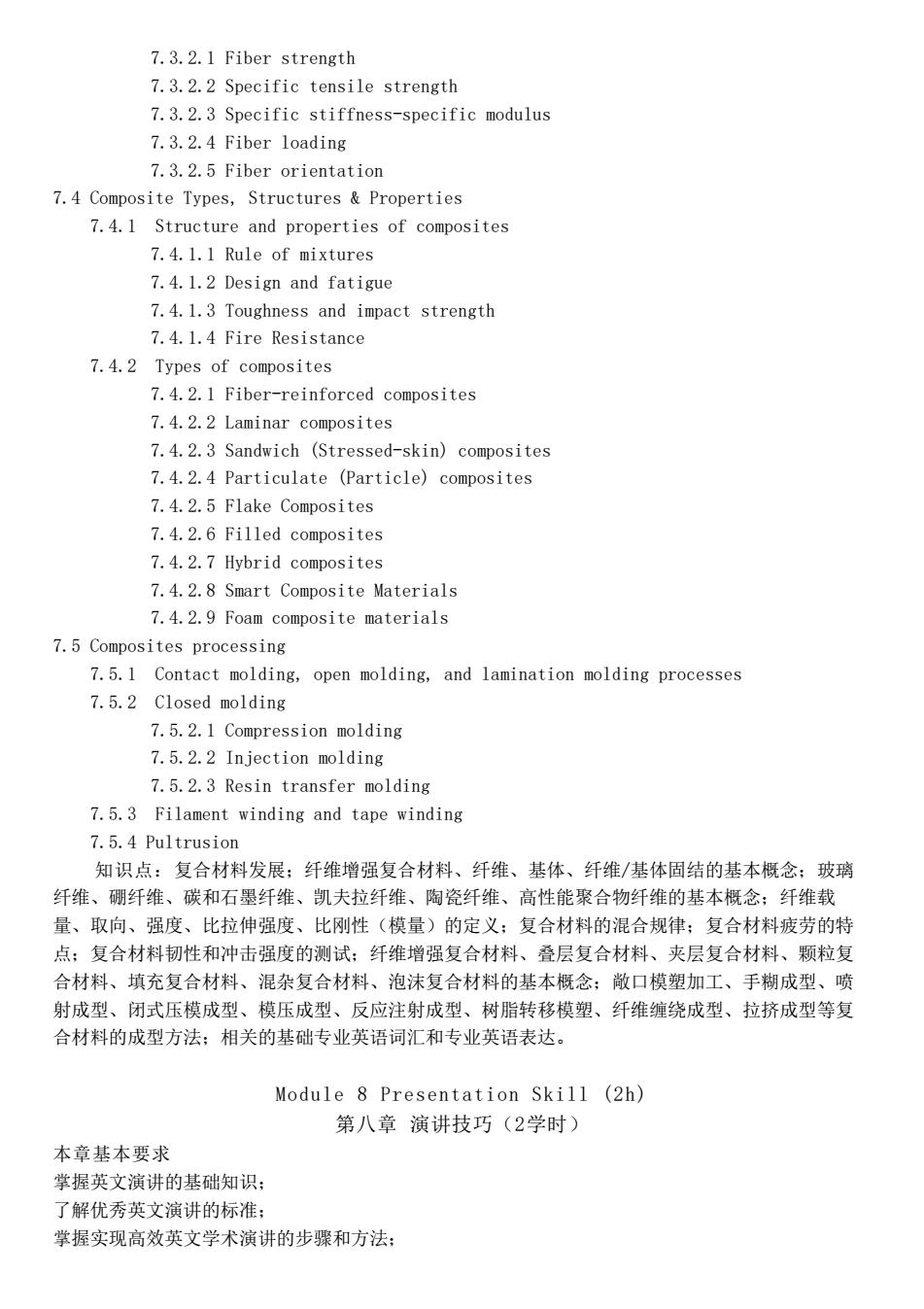
7.3.2.1 Fiber strength 7.3.2.2 Specific tensile strength 7.3.2.3 Specific stiffness-specific modulus 7.3.2.4 Fiber loading 7.3.2.5 Fiber orientation 7.4 Composite Types,Structures Properties 7.4.1 Structure and properties of composites 7.4.1.1 Rule of mixtures 7.4.1.2 Design and fatigue 7.4.1.3 Toughness and impact strength 7.4.1.4 Fire Resistance 7.4.2 Types of composites 7.4.2.1 Fiber-reinforced composites 7.4.2.2 Laminar composites 7.4.2.3 Sandwich (Stressed-skin)composites 7.4.2.4 Particulate (Particle)composites 7.4.2.5 Flake Composites 7.4.2.6 Filled composites 7.4.2.7 Hybrid composites 7.4.2.8 Smart Composite Materials 7.4.2.9 Foam composite materials 7.5 Composites processing 7.5.1 Contact molding,open molding,and lamination molding processes 7.5.2 Closed molding 7.5.2.1 Compression molding 7.5.2.2 Injection molding 7.5.2.3 Resin transfer molding 7.5.3 Filament winding and tape winding 7.5.4 Pultrusion 知识点:复合材料发展:纤维增强复合材料、纤维、基体、纤维/基体固结的基本概念:玻璃 纤维、硼纤维、碳和石墨纤维、凯夫拉纤维、陶瓷纤维、高性能聚合物纤维的基本概念:纤维载 量、取向、强度、比拉伸强度、比刚性(模量)的定义:复合材料的湿合规律:复合材料店劳的特 点:复合材料韧性和冲击强度的测试:纤维增强复合材料、叠层复合材料、夹层复合材料、颗粒复 合材料、填充复合材料、混杂复合材料、泡沫复合材料的基本概念:散口模塑加工、手糊成型、喷 射成型、闭式压模成型、模压成型、反应注射成型、树脂转移模塑、纤维缠绕成型、拉挤成型等复 合材料的成型方法:相关的基础专业英语词汇和专业英语表达。 Module 8 Presentation Skill (2h) 第八章演讲技巧(2学时) 本章基本要求 掌握英文演讲的基础知识: 了解优秀英文演讲的标准: 掌握实现高效英文学术演讲的步骤和方法:
7.3.2.1 Fiber strength 7.3.2.2 Specific tensile strength 7.3.2.3 Specific stiffness-specific modulus 7.3.2.4 Fiber loading 7.3.2.5 Fiber orientation 7.4 Composite Types, Structures & Properties 7.4.1 Structure and properties of composites 7.4.1.1 Rule of mixtures 7.4.1.2 Design and fatigue 7.4.1.3 Toughness and impact strength 7.4.1.4 Fire Resistance 7.4.2 Types of composites 7.4.2.1 Fiber-reinforced composites 7.4.2.2 Laminar composites 7.4.2.3 Sandwich (Stressed-skin) composites 7.4.2.4 Particulate (Particle) composites 7.4.2.5 Flake Composites 7.4.2.6 Filled composites 7.4.2.7 Hybrid composites 7.4.2.8 Smart Composite Materials 7.4.2.9 Foam composite materials 7.5 Composites processing 7.5.1 Contact molding, open molding, and lamination molding processes 7.5.2 Closed molding 7.5.2.1 Compression molding 7.5.2.2 Injection molding 7.5.2.3 Resin transfer molding 7.5.3 Filament winding and tape winding 7.5.4 Pultrusion 知识点:复合材料发展;纤维增强复合材料、纤维、基体、纤维/基体固结的基本概念;玻璃 纤维、硼纤维、碳和石墨纤维、凯夫拉纤维、陶瓷纤维、高性能聚合物纤维的基本概念;纤维载 量、取向、强度、比拉伸强度、比刚性(模量)的定义;复合材料的混合规律;复合材料疲劳的特 点;复合材料韧性和冲击强度的测试;纤维增强复合材料、叠层复合材料、夹层复合材料、颗粒复 合材料、填充复合材料、混杂复合材料、泡沫复合材料的基本概念;敞口模塑加工、手糊成型、喷 射成型、闭式压模成型、模压成型、反应注射成型、树脂转移模塑、纤维缠绕成型、拉挤成型等复 合材料的成型方法;相关的基础专业英语词汇和专业英语表达。 Module 8 Presentation Skill (2h) 第八章 演讲技巧(2学时) 本章基本要求 掌握英文演讲的基础知识; 了解优秀英文演讲的标准; 掌握实现高效英文学术演讲的步骤和方法;
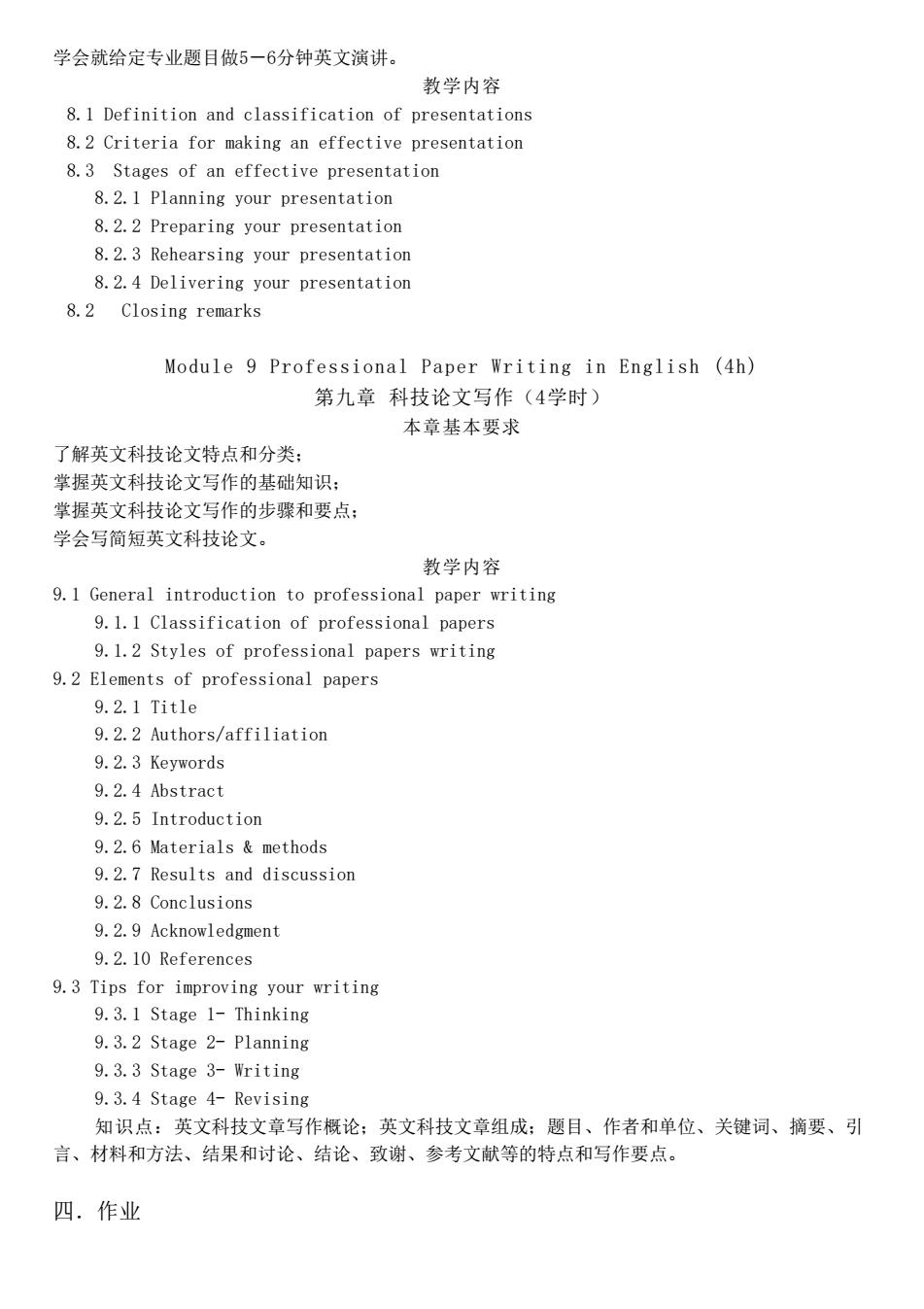
学会就给定专业题目做5一6分钟英文演讲。 教学内容 8.1 Definition and classification of presentations 8.2 Criteria for making an effective presentation 8.3 Stages of an effective presentation 8.2.1 Planning your presentation 8.2.2 Preparing your presentation 8.2.3 Rehearsing your presentation 8.2.4 Delivering your presentation 8.2 Closing remarks Module 9 Professional Paper Writing in English (4h) 第九章科技论文写作(4学时) 本章基本要求 了解英文科技论文特点和分类: 掌握英文科技论文写作的基础知识: 堂握英文利技论文写作的步暖和要点: 学会写简短英文科技论文。 教学内容 9.1 General introduction to professional paper writing 9.1.1 Classification of professional papers 9.1.2 Styles of professional papers writing 9.2 Elements of professional papers 9.2.1 Title 9.2.2 Authors/affiliation 9.2.3 Keywords 9.2.4 Abstract 9.2.5 Introduction 9.2.6 Materials&methods 9.2.7 Results and discussion 9.2.8 Conclusions 9.2.9 Acknowledgment 9.2.10 References 9.3 Tips for improving your writing 9.3.1 Stage 1-Thinking 9.3.2 Stage 2-Planning 9.3.3 Stage 3-Writing 9.3.4 Stage 4-Revising 知识点:英文科技文章写作概论:英文科技文章组成:题目、作者和单位、关键词、摘要、引 言、材料和方法、结果和讨论、结论、致谢、参考文献等的特点和写作要点。 四.作业
学会就给定专业题目做5-6分钟英文演讲。 教学内容 8.1 Definition and classification of presentations 8.2 Criteria for making an effective presentation 8.3 Stages of an effective presentation 8.2.1 Planning your presentation 8.2.2 Preparing your presentation 8.2.3 Rehearsing your presentation 8.2.4 Delivering your presentation 8.2 Closing remarks Module 9 Professional Paper Writing in English (4h) 第九章 科技论文写作(4学时) 本章基本要求 了解英文科技论文特点和分类; 掌握英文科技论文写作的基础知识; 掌握英文科技论文写作的步骤和要点; 学会写简短英文科技论文。 教学内容 9.1 General introduction to professional paper writing 9.1.1 Classification of professional papers 9.1.2 Styles of professional papers writing 9.2 Elements of professional papers 9.2.1 Title 9.2.2 Authors/affiliation 9.2.3 Keywords 9.2.4 Abstract 9.2.5 Introduction 9.2.6 Materials & methods 9.2.7 Results and discussion 9.2.8 Conclusions 9.2.9 Acknowledgment 9.2.10 References 9.3 Tips for improving your writing 9.3.1 Stage 1- Thinking 9.3.2 Stage 2- Planning 9.3.3 Stage 3- Writing 9.3.4 Stage 4- Revising 知识点:英文科技文章写作概论;英文科技文章组成;题目、作者和单位、关键词、摘要、引 言、材料和方法、结果和讨论、结论、致谢、参考文献等的特点和写作要点。 四.作业